by Winding Pathways | May 25, 2016 | Nature, Trees/Shrubs
Years ago a tremendous lightning bolt struck a white pine at the Indian Creek Nature Center in Cedar Rapids, Iowa.
The powerful blast tore a vertical strip of bark from nearly the tree’s top to the ground. It was at least 25 feet long and about four inches wide. Fearing that the hit was fatal I called then Cedar Rapids City Forester Eric Faaborg who came out and examined the pine.
I was certain it had suffered the kiss of death, but Eric reassured me. “I don’t think the hit was fatal. Give it a few years and see what happens,” he remarked.
He was correct. By the next year the pine had partially healed. Now about 20 years later it is healthy and has grown considerably. The scar from the lightning wound is still visible but has faded.
The massive white oak that was struck by lightning near our home at Winding Pathways isn’t as lucky. Unlike the pine, the oak suffered extreme damage that extended all around the circumference of the tree. Four vertical strips of bark were torn off, and where bark remained it had been blown away from the tree’s wood. Essentially the oak has been girdled. We expect it to slowly die.
According to Cedar Rapids arborist, Todd Fagan, lightning damage often stresses a tree, causing it to go into decline and eventually die. It also opens the tree up to insects and diseases. However lightning damage isn’t always fatal. If in doubt he suggests contacting a certified arborist to evaluate the tree. Or you can simply leave it in place and remove if it dies.
Fagan added that it is possible to prevent lightning damage to special trees. “Often trees on golf courses are fitted with a copper wire that channels lightning harmlessly down into the ground. It’s expensive but can prevent the loss of an especially valuable tree,” he remarked.
To locate a certified arborist in your area access the website of the International Society of Aboriculture at and click on the appropriate link.
by Winding Pathways | May 16, 2016 | Geology/Weather, Nature, Trees/Shrubs
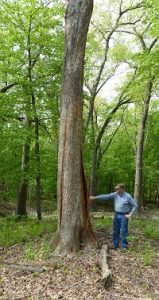
This stately Oak took a full bodies hit that vaporized the sap and blew off the bark in four places.
An enormous explosion brought us bolt upright in bed. 10:44 p.m. just after we’d fallen asleep on April 27th. . The blast was so powerful it knocked pictures off the wall shattering the frames and glass. A quick check revealed no other home damage and a few low rumbles assured us that the noise had been thunder created by a very close lighting strike and not a bomb.
A few days later we discovered a massive white oak about 300 feet from our home with its bark blown off in four different places and loose in others. The lightning’s heat and force vaporized the tree’s sap and enormous pressure blew the bark off. It’s hard to imagine that so much damage could happen in a two tenths of a second-long lightning bolt. The thing is, the tree top is lower than our home! Why did lightning strike there and not the house?
A lightning strike isn’t always a tree’s kiss of death. If only a narrow swath of bark is blown off it may recover. But we fear our magnificent oak was so damaged that its days are numbered.
The tree’s imminent death is good news for small songbirds, especially brown creepers that seek shelter between loose bark and a tree’s trunk. As the oak gradually deteriorates it will provide food and shelter for a host of insects and the woodpeckers that love dining on them. We anticipate a day when our pileated, red headed, red bellied, hairy and downy woodpeckers nest in the old oak snag. Eventually it will topple over and over time return nutrients from rotting wood to the soil.
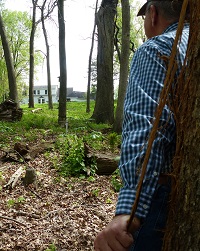
The distance from the lightning strike to the house is about a football field.
Lighting can be both lethal and sneaky. Every year it strikes about 25 million times in the United States and kills an average of 49 people. Many more humans are hit but survive, often with lingering physical problems. Ligntning is nothing to fool around with. As we learned on April 27th sometimes lightning strikes well before the main storm arrives and after it leaves. The safest place to be is inside a building away from windows, pipes, water, wires and landline telephones.
To stay safe, follow the 30-30 rule of thumb. When you first see lightning, begin to count “One Mississippi, two Mississippi….” until you hear thunder. If you hear thunder before you reach the number 30, lightning from the storm is in striking distance. Go inside! And, after the last rumble of thunder wait 30 minutes before venturing outside again.
An outstanding source of information, including many safety tips, is on the US Government’s website.
by Winding Pathways | Apr 19, 2016 | Labyrinths, Nature, Trees/Shrubs, Wonderment
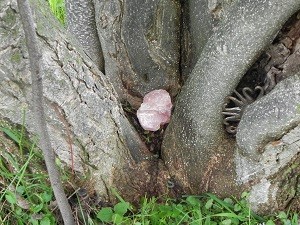
Heart of the tree
A short reflection walking in the Laughing Labyrinth.
by Winding Pathways | Mar 9, 2016 | Nature, Trees/Shrubs
Imagine an enormous elephant in the back yard, its huge tusks smashing a tree while it gobbles leaves, branches, and fruits. It once happened! Mastodons, mammoths, camels, horses, and sloths were once native Iowa wild animals before they slipped into extinction some 10,000 years ago.
They dined on the fruit of a long suffering tree that is getting a new lease on life because oil in its seeds promotes beautiful, healthy hair.
The humble Osage orange tree once grew across a vast area of North America. Scrubby, small, and prickly it thrived in poor soil and challenging climates. Today, its range is limited. On its thorny branches grow softball sized warty green fruits often called hedge apples or hedge balls. Without elephants to harvest them they drop to the ground and rot. Any seeds that might sprout can’t grow in their parent’s shade.
Elephants and sloths once devoured these hedge balls and wandered off, digesting the fleshy part and pooping out the seeds a distance from the parent tree. In exchange for a meal the animal planted a new tree generation. Around 13,000 years ago humans appeared and with razor sharp spears decimated the tasty animals. Lacking big mammals to spread its seeds the tree’s range slowly shrank to a small area of Texas and Oklahoma. Then people gave it a helping hand.
Farmers homesteaded the Midwest before barbed wire was invented. They needed fences and planted rows of Osage orange trees that grew into long linear impenetrable tangles. For a while the tree was valued and planted far and wide. When barbed wire was invented it rendered living fences obsolete and the hapless tree again went into decline. Then it got lucky, again.
Now cosmetologists are replacing elephants and farmers as the newest partners of this humble tree. Iowa chemist, Todd Johnson, learned how to extract oil from its seeds. When used as an ingredient in hair care products it promotes healthy hair. According to Capri College of Cosmetology Director of Education, Madison Seaborn, Osage orange oil is used in shampoo, cleansing conditioner, and volumizing gel.
Johnson buys tons of Osage orange fruits from farmers and youth groups and processes them into oil that’s sold to cosmetologists. Once again the Osage orange has value, and it’s likely that people will plant new ones as aging trees die.
Wooly mammoths and mastodons had long fine hair that kept them toasty warm in the cold glacial climate. Perhaps the oil that today is valued as a human hair care product once kept their fur in prime condition.
by Winding Pathways | Feb 2, 2016 | (Sub)Urban Homesteading, Foraging, Nature, Travel/Columns, Trees/Shrubs
Late this winter and early spring dozens of maple syrup festivals will shake the winter blahs. From the Midwest to the Atlantic and from the mid-South to Canada folks will be getting outside as days lengthen and temperatures warm to welcome the season’s first harvest.
Most festivals feature tree tapping and boiling demonstrations as well as delicious pancakes topped with local maple syrup.
-

-
For over 40 years, the Indian Creek Nature Center has hosted families at their two day festival.
-
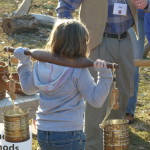
-
Children love to re-live harvesting methods.
-

-
Explaining the evaporation process.
-
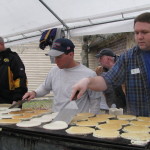
-
Volunteers arrive early at Indian Creek Nature Center’s Festival to serve hungry families.
-
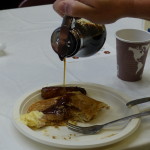
-
Just enough to finish the pancakes and sausage.
-

-
Sweet Surrender!
There’s likely a festival near your home. Just type into your search engine MAPLE SYRUP FESTIVAL IN (your state or province) and details will pop up. Here are just a few:
Indian Creek Nature Center Maple Syrup Festival. Cedar Rapids, Iowa
Indiana National Maple Fest. Brown County, Indiana
Mt. Rogers Maple Syrup Festival. Virginia
Elmira Maple Syrup Festival. Elmira, Ontario, Canada
by Winding Pathways | Feb 1, 2016 | (Sub)Urban Homesteading, Foraging, Nature, Trees/Shrubs
Preparing for the season’s first food harvest is a fun way to spend a few hours during winter’s deep freeze. Cornell University Cooperative and New York’s DNR have an excellent PDF “Maple Syrup Production for the Beginner.” Wikipedia features a comprehensive overview of syruping.
Trees of many maple species will flow sweet sap as soon as daytime temperatures rise into the high 30s while nights drop below the freezing point. That can happen in early February down South and six weeks later in Canada.
Syruping is fun, educational and a wonderful activity to share with children. It can be done far beyond the classic syruping regions of New England, Canada and the Lake States. We’ve been in touch with families from North Dakota to North Carolina who make maple syrup. We’ve made gallons in Iowa. All it takes is a tree or two of any maple species, the right weather and simple tools. When done properly, it doesn’t hurt the tree. Silver, sugar, black, and red maples all run sweet sap. So does the box elder, which is a true maple.
You’ll find past blogs on Winding Pathways that show how to make simple syruping equipment. Type maple syruping in the search box at the bottom of the screen or click on this link. Almost everyone already has everything needed to make small quantities of syrup, but it’s easier and a bit more sanitary to use manufactured equipment.
Many companies sell syruping equipment, but most are geared to supply large commercial operations. Tap My Trees is different. They sell easy-to-use equipment to folks wanting to tap a few backyard trees. Their website also includes helpful information on how to tap trees, collect sap, and boil it into syrup. Check it out!
-
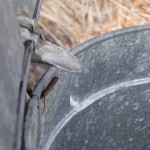
-
Clear sap dripping into the bucket.
-

-
A clean milk jug makes a simple “bucket” to collect sap.
-
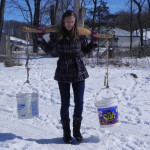
-
Carrying “modern buckets” on a yoke.
-
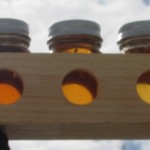
-
Maple Syrup’s taste is stronger with a deeper amber.
-
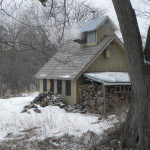
-
A traditional sugar shack
-
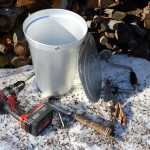
-
Modern equipment make backyard syruping easy and pleasurable.















